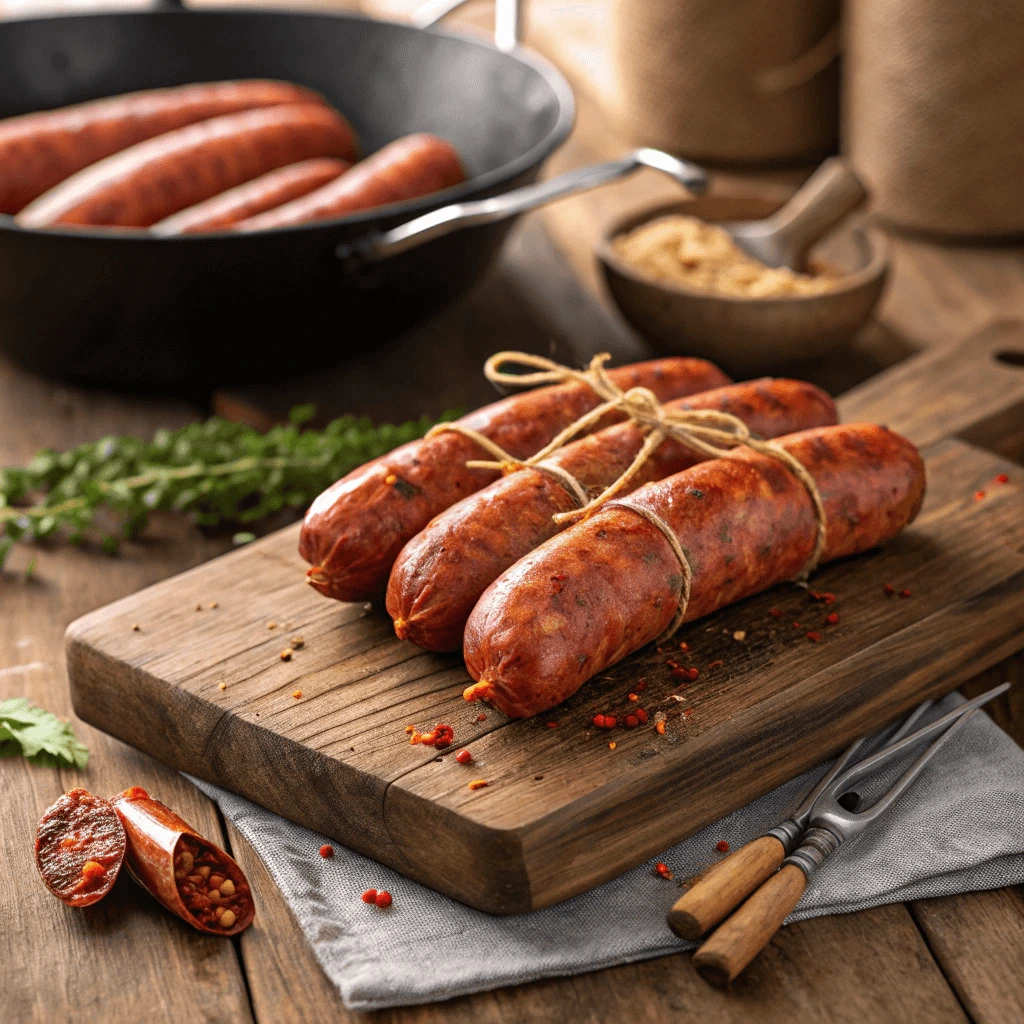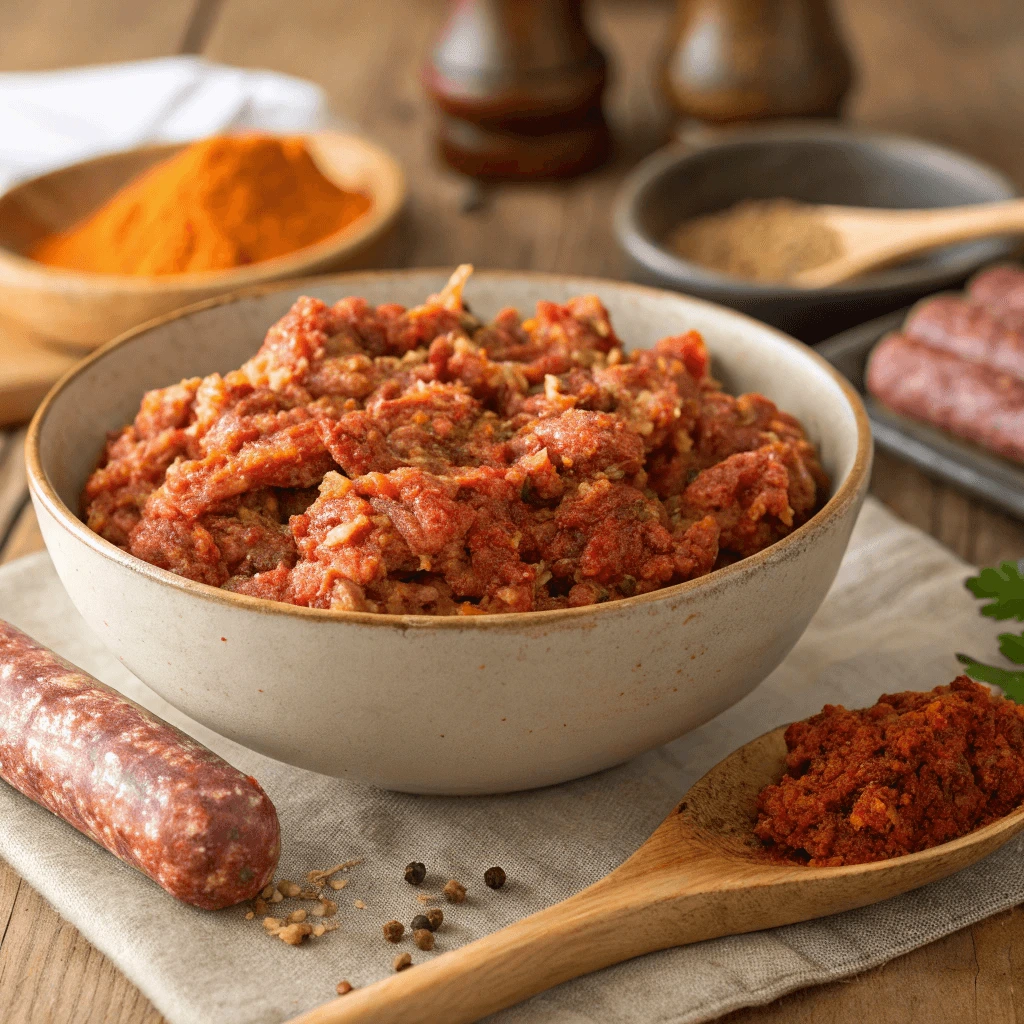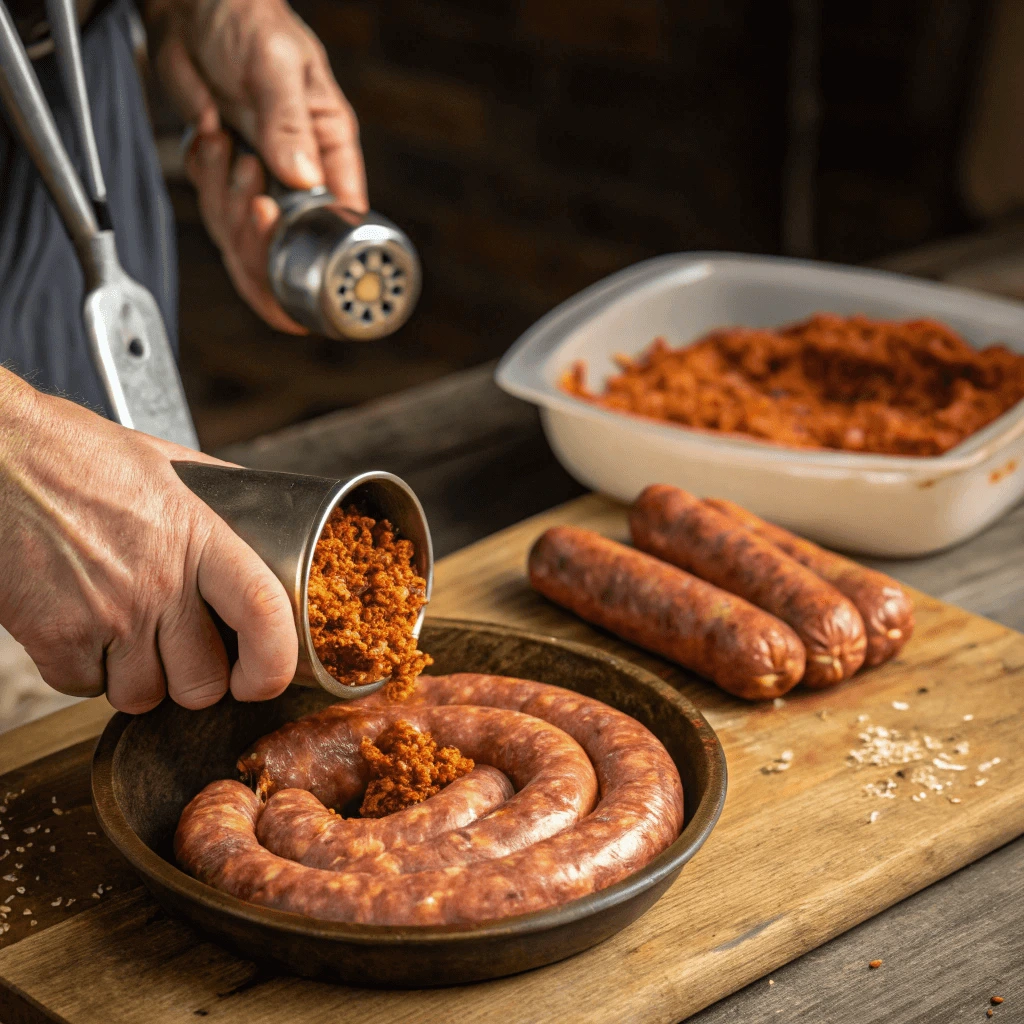Love bold, smoky, and spicy flavors? Chicken Andouille sausage is a delicious, lean alternative to the traditional pork version. It delivers the same rich taste but with a healthier twist. You can use it in gumbo, jambalaya, étouffée, or any Cajun-inspired dish.
In this guide, you’ll learn how to pick the right ingredients, season the sausage perfectly, and cook it using the best methods. No pork needed—just pure, flavorful goodness. Let’s get started on making the perfect chicken Andouille sausage at home!
What Makes Chicken Andouille Sausage Unique?

The Cajun and Creole Roots of Andouille Sausage
French Origins of Andouille
Andouille sausage started with French settlers who brought their sausage-making traditions to Louisiana. In France, Andouille was usually a mild pork sausage. When these settlers arrived in Louisiana, they adapted the recipe to use local ingredients and stronger seasonings. This change reflected the region’s mix of French, Spanish, African, and Native American influences.
Cajun vs. Creole Flavor Differences
Cajun Andouille sausage is known for its smoky, spicy profile and hearty texture. Creole Andouille, in contrast, offers a more complex blend of herbs with a touch less heat. Both styles rely on signature spices like garlic, cayenne, smoked paprika, and thyme to create bold, savory flavor.
Andouille’s Role in Louisiana Cuisine
Andouille sausage is a staple in dishes like gumbo, jambalaya, and red beans and rice. These recipes showcase the sausage’s smoky richness and its importance in Louisiana’s food culture. Making Chicken Andouille Sausage at home lets you enjoy these traditional flavors in a healthier, modern way.
How Chicken Andouille Differs From Pork Andouille
Texture and Fat Content
Chicken Andouille has a lighter texture than pork Andouille. Pork sausage tends to be denser and richer because of its higher fat content. Chicken, especially when made with thighs, keeps the sausage juicy but leaner overall.
Flavor Differences
Both types use bold Cajun spices like cayenne, garlic, and smoked paprika. However, chicken’s milder taste lets the seasonings stand out more. Pork’s natural richness softens the spice a bit, while chicken brings the heat and smoke forward.
A Healthier Choice
Chicken Andouille contains less saturated fat and fewer calories. It works well for those looking for a lighter or pork-free option without losing that classic Andouille flavor.
Why Homemade Chicken Andouille Sausage Is Better
Full Control Over Ingredients
When you make Chicken Andouille Sausage at home, you choose exactly what goes into it. You can select high-quality chicken, adjust the fat content, and skip fillers or preservatives that store-bought sausages often contain. This control helps you create a cleaner, healthier sausage that suits your taste.
Customizable Flavor
Homemade sausage gives you the freedom to fine-tune the spice level. You decide how much cayenne, smoked paprika, garlic, or herbs to use. Want it smokier? Add extra paprika or try different wood chips in your smoker. Prefer it mild? Dial back the cayenne. You create the perfect balance for your palate.
Better Texture and Freshness
Freshly made Chicken Andouille Sausage often has a superior texture. Store-bought versions can feel rubbery or dry because they sit on shelves or in freezers for long periods. By grinding your own chicken and stuffing the sausage yourself, you ensure a juicy, firm bite every time.
Essential Ingredients for the Perfect Chicken Andouille Sausage

Best Cuts of Chicken to Use (Thighs vs. Breast)
Why Chicken Thighs Work Best
Chicken thighs bring natural juiciness and flavor to Andouille sausage. Their higher fat content keeps the sausage moist during smoking or cooking. Thigh meat also provides a rich, savory taste that pairs well with Cajun spices like smoked paprika, garlic, and cayenne. When you want sausage with a tender, succulent bite, chicken thighs deliver the best result.
When to Use Chicken Breast
Chicken breast offers a leaner alternative. It has a mild flavor and lower fat, which makes it a good option for those who want a lighter sausage. However, breast meat can dry out more easily during cooking, so you may want to combine it with thighs for better moisture and texture.
Blending for the Right Balance
Many home cooks choose to blend thighs and breast. This mix lets you control both fat content and flavor. For example, using 70% thigh and 30% breast creates a sausage that stays juicy but isn’t overly rich. Grinding the cuts together ensures even seasoning and a consistent texture throughout the sausage.
Classic Andouille Sausage Spices and Seasonings
The Foundation: Garlic and Onion Powder
Garlic and onion powder form the base of classic Andouille sausage seasoning. They add depth and savoriness that complement the smoky flavor. Fresh garlic can work, but the powdered versions distribute flavor evenly throughout the sausage mixture.
The Heat: Cayenne Pepper and Black Pepper
Cayenne pepper gives Andouille its signature spicy kick. It balances heat without overwhelming the palate. Black pepper adds a sharp, pungent layer that enhances the overall spice profile. Adjusting the amount of cayenne lets you control how fiery your chicken Andouille turns out.
Smoky Flavor: Smoked Paprika
Smoked paprika delivers that essential smoky aroma and taste, even if you aren’t using a smoker. It mimics the flavor traditionally developed by smoking pork Andouille over hardwood. Using smoked paprika is key to replicating the authentic Creole and Cajun flavor in your chicken sausage.
Herbs That Complete the Flavor
Dried thyme and oregano bring earthy and herbal notes that round out the spice blend. These herbs contribute subtle complexity, balancing the heat and smoke. Some recipes also add a pinch of cayenne or a hint of white pepper for extra dimension.
Choosing the Right Casings or Alternatives
Natural Casings: The Traditional Choice
Natural casings come from cleaned animal intestines, most commonly hog or sheep. They provide a traditional texture and snap that many sausage lovers appreciate. Natural casings also allow smoke and seasoning to penetrate better, enhancing flavor during cooking. If you want an authentic Chicken Andouille experience, natural casings remain the top choice.
Collagen Casings: Convenient and Versatile
Collagen casings offer a consistent size and shape, making them easier to work with than natural casings. Many home cooks prefer collagen because they’re widely available and don’t require soaking or rinsing before use. These casings hold up well during smoking and cooking but sometimes lack the “snap” of natural casings.
Casing-Free Alternatives: Sausage Style Without Casings
If you don’t want to use casings, you can make casing-free Chicken Andouille sausage by forming patties or loose sausage meat. This method simplifies the process and works well for recipes like gumbo or jambalaya, where the sausage will be crumbled. Keep in mind that this style won’t have the firm texture or shape of traditional links but still delivers that spicy, smoky flavor.
Step-by-Step Guide: How to Make Chicken Andouille Sausage

Preparing and Grinding the Chicken
Selecting and Preparing the Meat
Start with fresh, high-quality chicken thighs or a blend of thighs and breasts. Trim away any excess skin or cartilage to avoid chewy bits in your sausage. Cutting the chicken into smaller chunks before grinding helps the process go smoothly. Keep the meat cold to prevent smearing during grinding, which can affect texture.
Chilling for Better Grinding
Place the cut chicken pieces in the freezer for about 20 to 30 minutes. Slightly frozen meat grinds more evenly and produces a firmer sausage texture. Avoid freezing the meat solid, as this can damage the grinder and affect the final result.
Grinding the Chicken
Use a meat grinder or a powerful food processor to grind the chicken. If you want a coarser texture, use a larger grinding plate; for finer sausage, choose a smaller plate. Grind the meat twice for an even consistency, especially if you include both thighs and breasts. After grinding, keep the meat cold to maintain freshness.
Mixing and Seasoning
Once ground, combine the chicken with your spice blend thoroughly. Use clean hands or a sturdy spoon to mix evenly, ensuring every bite contains a perfect balance of flavor. Chill the mixture before stuffing or shaping to help it bind properly.
Mixing the Seasonings for Authentic Cajun Flavor
Gathering Your Spices
Start by collecting all the key Cajun spices: garlic powder, onion powder, cayenne pepper, smoked paprika, black pepper, thyme, and oregano. Using fresh, high-quality spices ensures the best flavor in your Chicken Andouille sausage. Measure each ingredient carefully to maintain the right balance.
Balancing Heat and Flavor
Cajun seasoning shines when it balances heat and flavor. Cayenne pepper provides the signature spicy kick, but be careful not to overpower the sausage. Adjust the amount based on your spice tolerance. Smoked paprika adds deep smokiness, while garlic and onion powders provide savory undertones. Black pepper and thyme round out the blend with a subtle warmth.
Combining the Spices with the Meat
Sprinkle the seasoning evenly over the ground chicken. Use clean hands or a sturdy spoon to mix thoroughly. Work the mixture gently to distribute spices without overworking the meat, which can make the sausage dense. Mix until the spices coat every part of the meat evenly, ensuring consistent flavor in every bite.
Resting the Mixture
After mixing, let the seasoned meat rest in the refrigerator for at least an hour. This step allows the spices to meld with the chicken, enhancing the overall flavor. The resting period also helps the sausage hold together better during cooking or smoking.
Stuffing and Forming Your Sausage Links
Preparing the Casings
Start by soaking natural casings in warm water for about 30 minutes. This softens them and makes them easier to handle. Rinse the casings inside and out under cold running water to remove any salt or impurities. If you use collagen casings, follow the package instructions as they usually require less prep.
Filling the Sausage Stuffer
Attach the appropriate-sized stuffing tube to your sausage stuffer or meat grinder. Load the seasoned ground chicken mixture into the hopper, packing it down to avoid air pockets. Air pockets can cause uneven cooking or bursting during smoking.
Stuffing the Casings
Slide the casing onto the stuffing tube, leaving a few inches hanging off the end to tie later. Gently feed the meat mixture through the stuffer, guiding the casing with your other hand. Keep steady pressure to avoid tearing the casing. Twist the filled casing at intervals to form individual sausage links.
Forming Even Links
Make links about 5 to 6 inches long for traditional Andouille sausages. To separate the links, twist the casing in alternating directions to keep them tight and uniform. If you notice any air bubbles, prick them gently with a pin or needle to release trapped air.
Resting Before Cooking
Once stuffed and linked, refrigerate the sausages for a few hours or overnight. This resting time helps the flavors meld and the sausage firm up, making them easier to handle during cooking or smoking.
Smoking and Cooking Chicken Andouille Sausage at Home
Best Wood Chips for Smoking Chicken Sausage
Why Wood Choice Matters
Choosing the right wood chips dramatically affects the flavor of your smoked chicken Andouille sausage. Different woods produce distinct smoke aromas, which can complement or overpower the spices and natural taste of the sausage. Selecting the perfect wood enhances the authentic Cajun flavor.
Mild Woods: Apple and Cherry
Apple and cherry wood chips offer a mild, sweet smoke that pairs beautifully with chicken. They add subtle fruity notes that enhance the seasoning without overpowering the sausage’s natural flavors. These woods work well if you prefer a gentle smoke that complements rather than dominates.
Medium Woods: Hickory and Oak
Hickory provides a stronger, bacon-like smoky flavor that suits traditional Andouille sausages well. Oak offers a balanced, medium smoke that’s not too intense but still adds depth. Both woods create the classic smoky profile many expect from Cajun-style sausages. Hickory, in particular, gives that rich, savory boost.
Avoiding Strong Woods: Mesquite and Pecan
Mesquite smoke tends to be very intense and can quickly overpower chicken sausage’s delicate taste. Pecan, while flavorful, leans toward a nutty and heavy smoke that might clash with the spices. For chicken Andouille, it’s best to use these woods sparingly or mix them with milder woods to avoid overwhelming the flavor.
Tips for Using Wood Chips
Soak your wood chips in water for about 30 minutes before adding them to your smoker or grill. This soaking slows burning, allowing for steady, even smoke release. Use a small handful at a time to maintain a consistent smoke level without making the sausage bitter.
Temperature and Time for Smoking Andouille Sausage
Ideal Smoking Temperature
Maintain your smoker between 225°F and 250°F (107°C to 121°C). This low and slow temperature range allows the sausage to cook evenly and absorb the smoky flavors without drying out. Avoid high heat, which can cause the casings to burst or the sausage to become tough.
Recommended Smoking Time
Plan to smoke your Chicken Andouille sausage for about 2 to 3 hours. The exact time depends on the sausage’s thickness and your smoker’s consistency. Smoking for too long can dry out the sausage, while smoking too briefly might leave it undercooked inside.
Checking Internal Temperature
Use a reliable meat thermometer to check doneness. Chicken sausage should reach an internal temperature of 165°F (74°C) for safe consumption. Insert the thermometer into the thickest part of the sausage to get an accurate reading. Pull the sausage from the smoker once it hits this temperature.
Resting After Smoking
After smoking, let the sausage rest for 10 to 15 minutes. Resting helps redistribute the juices, keeping the sausage moist and flavorful when sliced. During this time, the sausage will finish cooking slightly, so plan accordingly.
Alternative Cooking Methods Without a Smoker
Using an Oven for Baking
If you don’t have a smoker, baking your Chicken Andouille sausage in the oven is an excellent option. Preheat your oven to 300°F (150°C). Place the sausages on a baking sheet lined with parchment paper or a wire rack. Bake them for about 30 to 40 minutes, turning occasionally to ensure even cooking. Baking at a low temperature helps the sausages cook through without drying out.
Pan Searing for Quick Cooking
Pan searing offers a fast and flavorful way to cook your sausages. Heat a little oil in a skillet over medium heat. Add the sausages and cook them for about 12 to 15 minutes, turning frequently to brown all sides evenly. This method creates a nice crust while keeping the inside juicy. Be careful to avoid overcrowding the pan, which can cause steaming rather than searing.
Grilling for Charred Flavor
Grilling your Chicken Andouille sausage adds a smoky, charred flavor even without a dedicated smoker. Preheat the grill to medium heat. Place the sausages directly on the grill grates and cook for about 10 to 15 minutes, turning regularly to avoid burning. Use indirect heat if your grill tends to flare up, to prevent the casings from bursting.
Simmering Before Browning
Another alternative is to simmer the sausages in water or broth before finishing them on a pan or grill. Simmering at low heat for about 10 minutes cooks the sausage evenly and reduces the risk of bursting. After simmering, brown them in a skillet or on a grill for added texture and flavor.
Serving and Storing Your Homemade Chicken Andouille Sausage
Delicious Dishes Featuring Chicken Andouille Sausage
Classic Cajun Jambalaya
Chicken Andouille sausage plays a starring role in Cajun jambalaya, a hearty one-pot dish filled with rice, vegetables, and spices. The spicy sausage adds bold flavor and a satisfying smoky kick. Simply slice the sausage and sauté it with onions, bell peppers, and celery before combining with rice and broth. This dish perfectly showcases the sausage’s robust taste.
Spicy Gumbo
Gumbo, a rich stew with a dark roux base, benefits greatly from the addition of chicken Andouille sausage. The sausage’s spices infuse the broth, complementing the seafood or chicken often included in the recipe. Cut the sausage into bite-sized pieces and simmer it with okra, tomatoes, and your favorite vegetables for a comforting, flavorful meal.
Sausage and Peppers
For a simple yet delicious option, cook sliced chicken Andouille sausage with sautéed bell peppers and onions. This dish works great as a main course or a sandwich filling. The smoky, spicy sausage pairs well with the sweetness of the peppers, creating a balanced and satisfying flavor combination.
Pasta with Chicken Andouille
Add sliced chicken Andouille sausage to pasta dishes for a Cajun twist. Sauté the sausage with garlic and tomatoes, then toss it with cooked pasta and a sprinkle of Parmesan cheese. The sausage adds a smoky depth that elevates even simple pasta recipes.
Grilled Sausage Skewers
Thread chunks of chicken Andouille sausage onto skewers with vegetables like zucchini, onions, and cherry tomatoes. Grill the skewers over medium heat until the sausage is browned and vegetables are tender. These skewers make a perfect appetizer or a tasty addition to any barbecue.
How to Store and Freeze Homemade Sausage Safely
Storing Fresh Sausage in the Refrigerator
After making your Chicken Andouille sausage, store it in an airtight container or tightly wrapped in plastic wrap. Keep it in the coldest part of your refrigerator, ideally below 40°F (4°C). Use fresh sausage within 2 to 3 days to ensure the best flavor and food safety.
Preparing Sausage for Freezing
If you want to keep your sausage longer, freezing is the best option. Before freezing, wrap each link individually in plastic wrap or freezer paper. Then place the wrapped links into a resealable freezer bag, squeezing out as much air as possible. This double wrapping helps prevent freezer burn and maintains freshness.
Labeling and Dating
Label each freezer bag with the date you froze the sausage. Homemade sausage keeps well in the freezer for up to 3 months. Using the oldest batches first ensures you enjoy them at their best quality.
Thawing Frozen Sausage Safely
When ready to use, thaw frozen sausage in the refrigerator overnight. Avoid thawing at room temperature to prevent bacterial growth. If you’re short on time, use the microwave’s defrost setting, but cook the sausage immediately afterward.
Cooking from Frozen
In some cases, you can cook sausage directly from frozen. Adjust cooking times accordingly, usually adding about 5 to 10 extra minutes. Check the internal temperature with a meat thermometer to ensure it reaches 165°F (74°C) for safe consumption.
Reheating and Enjoying Later Without Losing Flavor
Best Practices for Reheating
To preserve the smoky, spicy flavor of your Chicken Andouille sausage, reheat it gently. Use low heat methods like warming in a skillet over medium-low heat or baking in an oven preheated to 300°F (150°C). Avoid high heat that can dry out the sausage or cause the casing to split.
Using a Skillet for Reheating
Heat a small amount of oil or butter in a skillet. Add the sausage and turn frequently to warm it evenly. This method helps maintain the juicy texture while restoring a bit of the crispness on the casing. Cooking on medium-low heat prevents overcooking and flavor loss.
Oven Reheating for Even Warmth
Place the sausages on a baking sheet, cover loosely with foil, and warm them in the oven for about 10 to 15 minutes. This technique gently heats the sausage throughout while locking in moisture. Removing the foil during the last few minutes helps crisp the casing if desired.
Microwave Method – Use Caution
Microwaving is the fastest option but risks uneven heating and drying. To reduce this, place sausages on a microwave-safe plate, cover with a damp paper towel, and heat in short bursts of 30 seconds. Check frequently to avoid overheating.
Pairing Sausage With Fresh Ingredients
Enhance your reheated sausage by serving it with fresh sides like sautéed peppers, onions, or a zesty mustard sauce. These additions refresh the overall dish and complement the bold flavors of the Andouille.
Conclusion
Making the perfect Chicken Andouille Sausage at home combines quality ingredients, authentic spices, and careful preparation. By choosing the right cuts of chicken, mixing traditional Cajun seasonings, and smoking or cooking the sausage with proper temperature and timing, you can create a flavorful, juicy sausage that rivals any store-bought version. Homemade sausage lets you control the spice level and freshness, ensuring a delicious result every time. With these steps, you’ll enjoy authentic, smoky Chicken Andouille sausage crafted in your own kitchen.
